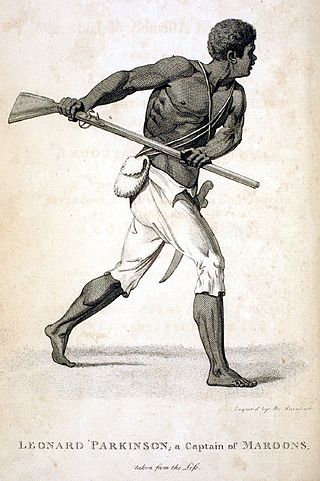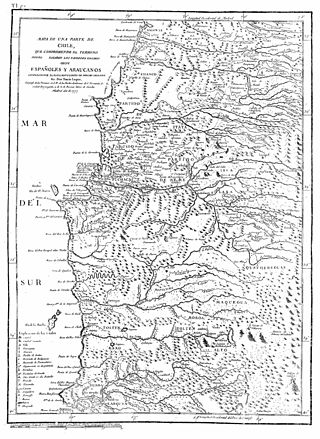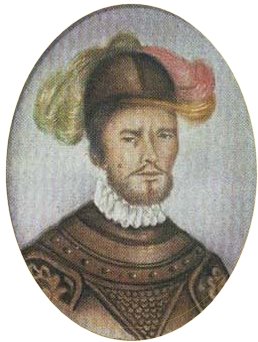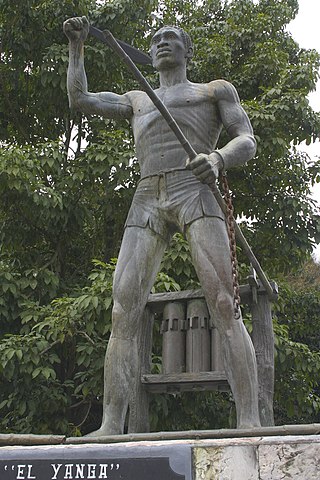
A slave rebellion is an armed uprising by slaves, as a way of fighting for their freedom. Rebellions of slaves have occurred in nearly all societies that practice slavery or have practiced slavery in the past. A desire for freedom and the dream of successful rebellion is often the greatest object of song, art, and culture amongst the enslaved population. These events, however, are often violently opposed and suppressed by slaveholders.

Pedro Gutiérrez de Valdivia or Valdiva was a Spanish conquistador and the first royal governor of Chile. After serving with the Spanish army in Italy and Flanders, he was sent to South America in 1534, where he served as lieutenant under Francisco Pizarro in Peru, acting as his second in command.

Maroons are descendants of Africans in the Americas and Islands of the Indian Ocean who escaped from slavery and formed their own settlements. They often mixed with indigenous peoples, eventually evolving into separate creole cultures such as the Garifuna and the Mascogos.

The Arauco War was a long-running conflict between colonial Spaniards and the Mapuche people, mostly fought in the Araucanía region of Chile. The conflict began at first as a reaction to the Spanish conquerors attempting to establish cities and force Mapuches into servitude. It subsequently evolved over time into phases comprising drawn-out sieges, slave-hunting expeditions, pillaging raids, punitive expeditions, and renewed Spanish attempts to secure lost territories. Abduction of women and war rape was common on both sides.

The Battle of Nájera, also known as the Battle of Navarrete, was fought on 3 April 1367 to the northeast of Nájera, in the province of La Rioja, Castile. It was an episode of the first Castilian Civil War which confronted King Peter of Castile with his half-brother Count Henry of Trastámara who aspired to the throne; the war involved Castile in the Hundred Years' War. Castilian naval power, far superior to that of France or England, encouraged the two polities to take sides in the civil war, to gain control over the Castilian fleet.

Panama is a predominantly Christian country, with Islam being a minority religion. Due to the secular nature of Panama's constitution, Muslims are free to proselytize and build places of worship in the country.

Pedro de Ursúa was a Spanish conquistador from Baztan in Navarre. He is best known for his final trip with Lope de Aguirre in search for El Dorado, where he found death in a plot.

Gaspar Yanga — often simply Yanga or Nyanga was an African who led a maroon colony of enslaved Africans in the highlands near Veracruz, Mexico during the early period of Spanish colonial rule. He successfully resisted a Spanish attack on the colony in 1609. The maroons continued their raids on Spanish settlements. Finally in 1618, Yanga achieved an agreement with the colonial government for self-rule of the maroon settlement. It was later called San Lorenzo de los Negros, and also San Lorenzo de Cerralvo.

Urracá or Ubarragá Maniá Tigrí was an Ngäbe Amerindian chieftain or cacique in the region of present-day Panama who fought effectively against the Spanish conquistadors. The Spaniards captured Urracá when he met them to discuss a peace treaty, caged him, and sent him to the Caribbean port of Nombre de Dios, intending to send him to Spain. He escaped, and for "the next eleven years", with his band of men, conducted guerrilla warfare against the conquistadors, living and hiding in the hills, ultimately dying from natural causes in 1531. Urraca commenced one of the first "sustained guerrilla wars in Latin America[n]"history and is remembered as el caudillo amerindio de Veragua and adversary of the Spanish Empire, the great resistance leader of Panama. He has been honored by his image on the centesimo, the smallest-denomination coin of Panama.

Jerónimo de Alderete y Mercado was a Spanish conquistador who was later named governor of Chile, but died before he could assume his post.

Afro-Panamanians are Panamanians of African descent. The Afro-Panamanian population can be mainly broken into one of two categories "Afro-Colonials", Afro-Panamanians descended from slaves brought to Panama during the colonial period, and "Afro-Antilleans," West Indian immigrant-descendants with origins in Trinidad, Martinique, Saint Lucia, Guadeloupe, Dominica, Grenada, Haiti, Belize, Barbados, and Jamaica, whose ancestors were brought in to build the Panama Canal. Afro-Panamanians can be found in the towns and cities of Colón, Cristóbal and Balboa, the Río Abajo area of Panama City, the Canal Zone and the province of Bocas del Toro.
Felipillo, was the leader of runaway slaves in Colonial Panama.
The Cimarrons in Panama were enslaved Africans who had escaped from their Spanish masters and lived together as maroons. In the 1570s, they allied with Francis Drake of England to defeat the Spanish conquest. In Sir Francis Drake Revived (1572), Drake describes the Cimarrons as "a black people which about eighty years past fled from the Spaniards their masters, by reason of their cruelty, and are since grown to a nation, under two kings of their own. The one inhabiteth to the west, the other to the east of the way from Nombre de Dios".
Race and ethnicity in Colombia descend mainly from three racial groups—Europeans, Amerindians, and Africans—that have mixed throughout the last 500 years of the country's history. Some demographers describe Colombia as one of the most ethnically diverse countries in the Western Hemisphere and in the World, with 900 different ethnic groups. Most Colombians identify themselves and others according to ancestry, physical appearance, and sociocultural status. Social relations reflect the importance attached to certain characteristics associated with a given racial group. Although these characteristics no longer accurately differentiate social categories, they still contribute to one's rank in the social hierarchy. A study at the University of Brasilia determined that the average Colombian has a mixture of European 43%, native Amerindian 39%, and African 8%. A study from 2010 involving 15 departments estimates the average Colombian to be 40.7% European, 44.8% Amerindian, and 14.5% African. These proportions also vary widely among ethnicities.
Diego García de Paredes y Vargas was a maestre de campo and a Spanish conquistador who participated in, among other things, the Battle of Cajamarca. He also founded Trujillo, Venezuela in 1557.
The Bayano Wars were armed conflicts in the Isthmus of Panama that occurred between the Bayano of Panama and the Spanish crown. The First War of the Bayano took place from 1548 to 1558, while the Second War took place from 1579 and 1582. Slavery, practiced since the early sixteenth century in Panama, brought many enslaved people from Africa to Spanish America. This brought successive slave uprisings against the rulers of the time, which was the origin for the Bayano Wars.

Guna de Madungandí or Madungandí, formerly known as Kuna de Madugandí is a comarca indígena and corregimiento in Chepo District, Panamá Province, Panama with a population of 4,271 as of 2010. It was created by Law 24 of January 12, 1996. Its population as of 2000 was 3,305.
Miguel I of Buría, also known as King Miguel, Miguel the Black and Miguel Guacamaya, was formerly enslaved in San Juan, Puerto Rico, and reigned as the King of Buría in the modern-day state of Lara, Venezuela. His incumbency began in 1552 and lasted until some point between 1553 and 1555.

The Militarized Communist Party of Peru is a political party and militant group in Peru that follows Marxism–Leninism–Maoism and participates in the communist insurgency in Peru. It is considered a terrorist organization by the government of Peru. The MPCP operates primarily in the VRAEM area and is involved in the area's coca production. Comrade José has been the leader of the MPCP since its official creation in 2018 after its final split from the declining Shining Path guerilla group.












